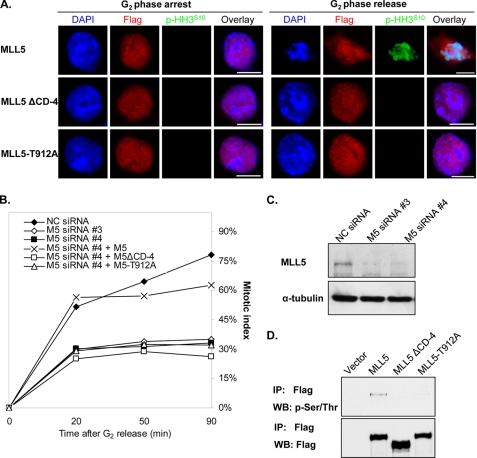FIGURE 7.
G2 arrest caused by the depletion of endogenous MLL5 can be rescued by exogenous expression of FLAG-MLL5 but not FLAG-MLL5ΔCD-4 or FLAG-MLL5-T912A. Endogenous MLL5 expression in HEK 293T cells were knocked down by siRNA, and FLAG-MLL5, FLAG-MLL5ΔCD-4, or FLAG-MLL5-T912A was transfected to rescue the cell cycle arrest. Cells were synchronized to G2 phase and allowed for mitotic progression. MLL5 localization was analyzed by immunofluorescence staining using anti-FLAG antibodies. Mitotic index was calculated by counting the phosphohistone H3Ser10-positive cells at 20, 50, and 90 min post-release. A, FLAG-MLL5 protein dissociated from chromosomes and the cells entered mitosis after G2 release for 20 min, as shown by positive histone H3Ser10 staining and chromosome condensation (1st row). FLAG-MLL5ΔCD-4 and FLAG-MLL5-T912A were restricted in nuclei, and there was no visible chromatin condensation, which was marked by histone H3Ser10 phosphorylation. Scale bar, 10 μm. DAPI, 4′,6-diamidino-2-phenylindole. B, cumulative mitotic index was calculated for control cells (NC siRNA), endogenous MLL5-knockdown cells (M5 siRNA #3 or M5 siRNA #4), FLAG-MLL5-positive cells (M5 siRNA #4 + M5), FLAG-MLL5ΔCD-4-positive cells (M5 siRNA #4 + M5ΔCD-4), and FLAG-MLL5-T912A-positive cells (M5 siRNA #4 + M5-T912A). C, Western blotting showed the successful knockdown of endogenous MLL5 by siRNA numbers 3 and 4. D, immunoprecipitation result showed that FLAG-MLL5ΔCD-4 and FLAG-MLL5-T912A could not be phosphosphorylated upon nocodazole treatment.

